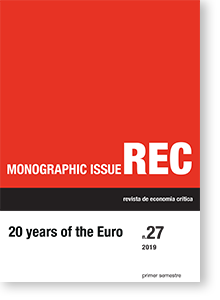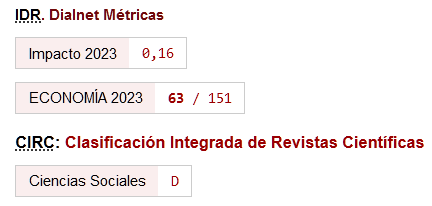20 Years of the German Euro Are More than Enough
Keywords:
euro, eurocrisis, Banking crisis, debt crisis, monetary policy, lender of last resortAbstract
This paper reviews the performance of the euro area since the euro’s launch 20 years ago. It argues that the euro crisis has exposed existential flaws in the euro regime. Intra-area divergences and the corresponding buildup of imbalances had remained unchecked prior to the crisis. As those imbalances eventually imploded, member states were found to be extremely vulnerable to systemic banking problems and abruptly deteriorating public finances. Debt legacies and high unemployment continue to plague euro crisis countries. Its huge current account surplus highlights that the euro currency union, toiling under the German euro and trying to emulate the German model, has become very vulnerable to global developments. The euro regime is flawed and dysfunctional. Europe has to overcome the German euro. Three reforms are essential to turn the euro into a viable European currency. First, divergences in competitiveness positions must be prevented in future. Second, market integration must go hand in hand with policy integration. Third, the euro is lacking a safe footing for as long as the ECB is missing a federal treasury partner. Therefore, establishing the vital treasury–central bank axis that stands at the center of power in sovereign states is essential.
Downloads
References
Avdjiev, S., B. Berger, H. S. Shin (2018): "Gauging procyclicality and financial vulnerability in Asia through the BIS banking and financial statistics." BIS Working Paper 735. Basel: Bank for International Settlements.
Baldwin, R., and F. Giavazzi (2015): "Towards a consensus on the causes of the EZ crisis." Voxeu.org, September 7.
Bibow, J. (2007a): "Global imbalances, Bretton Woods II, and Euroland's role in all this" in J. Bibow and A. Terzi (eds.) Euroland and the World Economy-Global Player or Global Drag? Basingstoke (UK): Palgrave Macmillan.
https://doi.org/10.1057/9780230377554
Bibow, J. (2007b): "How the Maastricht regime fosters divergence as well as instability" in P. Arestis, E. Hein, and E. Le Heron (eds.) Monetary Policies-Modern Approaches. Basingstoke (UK): Palgrave Macmillan.
https://doi.org/10.1057/9780230627345_11
Bibow, J. (2009): Keynes on Monetary Policy, Finance and Uncertainty: Liquidity Preference Theory and the Global Financial Crisis. London and New York: Routledge.
Bibow, J. (2012): "The Euroland crisis and Germany's euro trilemma." International Review of Applied Economics 27(3), pp. 360-85.
https://doi.org/10.1080/02692171.2012.721757
Bibow, J. (2013a): "Germany and the Euroland Crisis: The Making of a Vulnerable Haven." Levy Institute Working Paper 767. Annandale-on-Hudson, NY: Levy Economics Institute of Bard College.
https://doi.org/10.2139/ssrn.2285612
Bibow, J. (2013b): "Lost at sea: the euro needs a euro treasury", IMK Study No. 35. Düsseldorf: Hans Böckler Stiftung (IMK).
https://doi.org/10.2139/ssrn.2358070
Bibow, J. (2017): "From anti-growth bias to quantitative easing: The ECB's belated conversion?", in R. Mirdala and R. R. Canale (eds.), Economic Imbalances and Institutional Changes to the Euro and the European Union, International Finance Review, Volume 18. Somerville, MA: Emerald Publishing.
https://doi.org/10.1108/S1569-376720170000018007
Bibow, J. (2018): "How Germany's anti-Keynesianism has brought Europe to its knees" International Review of Applied Economics 32(5), pp. 569-88.
https://doi.org/10.1080/02692171.2017.1369938
Borio, C., R. McCauley, and P. McGuire (2011): "Global credit and domestic credit booms." BIS Quarterly Review September, pp. 43-57.
Borio, C., and P. Disyatat (2011): "Global imbalances and the financial crisis: Link or no link." BIS Working Paper 346. Basel: Bank for International Settlements.
https://doi.org/10.2139/ssrn.1859410
Borio, C., and P. Disyatat(2015): "Capital flows and the current account: Taking financing (more) seriously." BIS Working Paper 525. Basel: Bank for International Settlements.
Dustmann, C., B. Fitzenberger, U. Schönberg, and A. Spitz-Oener (2014): "From sick man of Europe to economic superstar: Germany's resurgent economy." Journal of Economic Perspectives 28(1), pp. 167-88.
https://doi.org/10.1257/jep.28.1.167
Dyson, K., and K. Featherstone (1999): The Road to Maastricht: Negotiating Economic and Monetary Union. Oxford: Oxford University Press.
https://doi.org/10.1093/019829638X.001.0001
Febrero, E., and F. Bermejo (2013): "Spain during the great recession: Teetering on the brink of collapse", in Ó. Dejuán, E. Febrero, and J. Uxó (eds.), Post-Keynesian Views of the Crisis and its Remedies. London: Routledge.
Febrero, E., J. Uxó, and F. Bermejo (2016): "The role of gross capital flows in the great financial crisis. The case of Spain." Conference paper delivered at the 20th FMM Conference, "Towards Pluralism in Macroeconomics?," October, 20-22, Berlin. [Forthcoming in Journal of Economic Issues (2019)]
Fernández, R., and C. García (2018): "Wheels within wheels within wheels: the importance of capital inflows in the origin of the Spanish financial crisis" Cambridge Journal of Economics 42, pp. 331-53.
https://doi.org/10.1093/cje/bex007
Flassbeck, H. (1997): "Und die Spielregeln für die Lohnpolitik in einer Währungsunion?" Frankfurter Rundschau, October 31. Available at: http://www.nachdenkseiten.de/upload/pdf/FR_Dokumentation_DRS_Freitag_31-10-1997_2.pdf
Flassbeck, H. (2007): "Wage divergences in Euroland: Explosive in the making", in J. Bibow and A. Terzi (eds.), Euroland and the World Economy-Global Player or Global Drag? Basingstoke (UK): Palgrave
https://doi.org/10.1057/9780230377554_3
Macmillan
Giersch, H., K.-H.Paque, and H. Schmieding (1992): The Fading Miracle: Four Decades of Market Economy in Germany, Cambridge: Cambridge University Press.
https://doi.org/10.1017/CBO9780511628542
Goodhart, C. A. E. (1998): "The two concepts of money: Implications for the analysis of optimal currency areas" European Journal of Political Economy 14, pp. 407-32.
https://doi.org/10.1016/S0176-2680(98)00015-9
Hefeker, C. (1994): "German monetary union, the Bundesbank and EMS collapse", Banca Nazionale del Lavoro Quarterly Review 47(191), pp. 379-98.
Hein, E., and A. Truger (2007): "Fiscal policy and macroeconomic performance in the euro area: Lessons for the future", in J. Bibow and A. Terzi (eds.), Euroland and the World Economy: Global Player or Global Drag? Basingstoke (UK): Palgrave Macmillan.
https://doi.org/10.1057/9780230377554_9
Hölscher, J. (1994): Entwicklungsmodell Westdeutschland. Aspekte der Akkumulation in der Geldwirtschaft. Berlin: Dunkcer & Humblot.
https://doi.org/10.3790/978-3-428-48046-3
Holtfrerich, C.-L. (1998): "Geldpolitik bei festen Wechselkursen (1948-1970)" in Deutsche Bundesbank (ed.), Fünfzig Jahre Deutsche Mar: Notenbank und Währung in Deutschland seit 1948. München: C. H. Beck.
Issing, O. (2008): The Birth of the Euro. Cambridge: Cambridge University Press.
James, H. (2012): Making the European Monetary Union. Cambridge, MA: Harvard University Press.
https://doi.org/10.4159/harvard.9780674068087
Lane, P. (2013): "Capital flows in the euro area" European Economy Economic Papers 476, pp. 1-54.
Milesi-Ferreti, G. M., R. Chen, and T. Tressel (2012): "External imbalances in the Euro area" IMF Working Paper 12/236. Washington, DC: International Monetary Fund.
https://doi.org/10.5089/9781475524673.001
Shin, H. S. (2012): "Global banking glut and loan risk premium" IMF Review 60(2), pp. 155-92.
https://doi.org/10.1057/imfer.2012.6
Veld, J. (2014): "International capital flows and the boom-bust cycle in Spain" European Economy Economic Papers 519, pp. 1-56.
https://doi.org/10.2139/ssrn.2436234
Wallich, H. C. (1955): Triebkräfte des deutschen Wiederaufstiegs. Frankfurt am Main: Fritz Knapp.
Waysand, C., K. Ross, and J. Guzmán (2010): "European financial linkages: A new look at imbalances" IMF Working Paper 10/295. Washington, DC: International Monetary Fund.
Downloads
Published
How to Cite
Issue
Section
License
This licence allows third parties to share (copy and redistribute the material in any medium or format) and adapt (remix, transform and create from the material for any purpose, including commercial purposes), provided that authorship and first publication in this journal (The Journal, DOI of the work) is acknowledged, a link to the licence is provided, and it is stated whether changes have been made to the work.







